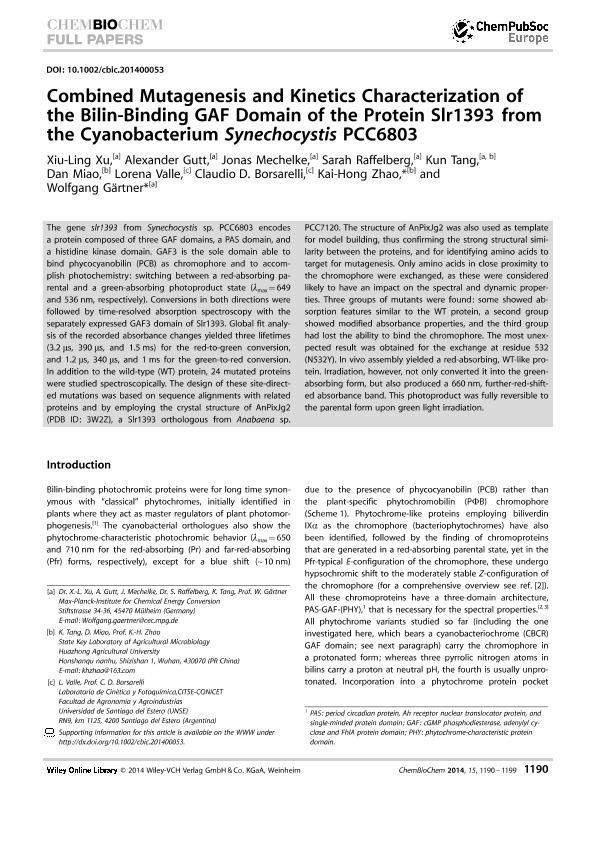Mostrar el registro sencillo del ítem
dc.contributor.author
Xu, Xiu Ling
dc.contributor.author
Gutt, Alexander
dc.contributor.author
Mechelke, Jonas
dc.contributor.author
Raffelberg, Sarah
dc.contributor.author
Tang, Kun
dc.contributor.author
Miao, Dan
dc.contributor.author
Valle, Lorena

dc.contributor.author
Borsarelli, Claudio Darío

dc.contributor.author
Zhao, Kai Hong
dc.contributor.author
Gärtner, Wolfgang
dc.date.available
2018-01-16T19:27:03Z
dc.date.issued
2014-04
dc.identifier.citation
Xu, Xiu Ling; Gärtner, Wolfgang; Zhao, Kai Hong; Borsarelli, Claudio Darío; Gutt, Alexander; Mechelke, Jonas; et al.; Combined Mutagenesis and Kinetics Characterization of the Bilin-Binding GAF Domain of the Protein Slr1393 from the Cyanobacterium Synechocystis PCC6803; Wiley VCH Verlag; Chembiochem; 15; 8; 4-2014; 1190-1199
dc.identifier.issn
1439-4227
dc.identifier.uri
http://hdl.handle.net/11336/33486
dc.description.abstract
The gene slr1393 from Synechocystis sp. PCC6803 encodes a protein composed of three GAF domains, a PAS domain, and a histidine kinase domain. GAF3 is the sole domain able to bind phycocyanobilin (PCB) as chromophore and to accomplish photochemistry: switching between a red-absorbing parental and a green-absorbing photoproduct state (lmax=649 and 536 nm, respectively). Conversions in both directions were followed by time-resolved absorption spectroscopy with the separately expressed GAF3 domain of Slr1393. Global fit analysis of the recorded absorbance changes yielded three lifetimes (3.2 ms, 390 ms, and 1.5 ms) for the red-to-green conversion, and 1.2 ms, 340 ms, and 1 ms for the green-to-red conversion. In addition to the wild-type (WT) protein, 24 mutated proteins were studied spectroscopically. The design of these site-directed mutations was based on sequence alignments with related proteins and by employing the crystal structure of AnPixJg2 (PDB ID: 3W2Z), a Slr1393 orthologous from Anabaena sp.PCC7120. The structure of AnPixJg2 was also used as template for model building, thus confirming the strong structural similarity between the proteins, and for identifying amino acids to target for mutagenesis. Only amino acids in close proximity to the chromophore were exchanged, as these were considered likely to have an impact on the spectral and dynamic properties. Three groups of mutants were found: some showed absorption features similar to the WT protein, a second group showed modified absorbance properties, and the third group had lost the ability to bind the chromophore. The most unexpected result was obtained for the exchange at residue 532 (N532Y). In vivo assembly yielded a red-absorbing, WT-like protein. Irradiation, however, not only converted it into the greenabsorbing form, but also produced a 660 nm, further-red-shifted absorbance band. This photoproduct was fully reversible to the parental form upon green light irradiation.
dc.format
application/pdf
dc.language.iso
eng
dc.publisher
Wiley VCH Verlag

dc.rights
info:eu-repo/semantics/openAccess
dc.rights.uri
https://creativecommons.org/licenses/by-nc-sa/2.5/ar/
dc.subject
Chromophores
dc.subject
Global Fit
dc.subject
Mutagenesis
dc.subject
Phycocyanobilin
dc.subject
Phytochromes
dc.subject
Time Resolved
dc.subject.classification
Otras Ciencias Biológicas

dc.subject.classification
Ciencias Biológicas

dc.subject.classification
CIENCIAS NATURALES Y EXACTAS

dc.title
Combined Mutagenesis and Kinetics Characterization of the Bilin-Binding GAF Domain of the Protein Slr1393 from the Cyanobacterium Synechocystis PCC6803
dc.type
info:eu-repo/semantics/article
dc.type
info:ar-repo/semantics/artículo
dc.type
info:eu-repo/semantics/publishedVersion
dc.date.updated
2018-01-16T18:24:32Z
dc.identifier.eissn
1439-7633
dc.journal.volume
15
dc.journal.number
8
dc.journal.pagination
1190-1199
dc.journal.pais
Alemania

dc.journal.ciudad
Weinheim
dc.description.fil
Fil: Xu, Xiu Ling. Max-Planck-Institute for Chemical Energy Conversion; Alemania
dc.description.fil
Fil: Gutt, Alexander. Max-Planck-Institute for Chemical Energy Conversion; Alemania
dc.description.fil
Fil: Mechelke, Jonas. Max-Planck-Institute for Chemical Energy Conversion; Alemania
dc.description.fil
Fil: Raffelberg, Sarah. Max-Planck-Institute for Chemical Energy Conversion; Alemania
dc.description.fil
Fil: Tang, Kun. Max-Planck-Institute for Chemical Energy Conversion; Alemania. Huazhong Agricultural University; República de China
dc.description.fil
Fil: Miao, Dan. Huazhong Agricultural University; República de China
dc.description.fil
Fil: Valle, Lorena. Consejo Nacional de Investigaciones Científicas y Técnicas. Centro de Investigaciones y Transferencia de Santiago del Estero. Universidad Nacional de Santiago del Estero. Centro de Investigaciones y Transferencia de Santiago del Estero; Argentina. Universidad Nacional de Santiago del Estero. Facultad de Agronomía y Agroindustrias; Argentina
dc.description.fil
Fil: Borsarelli, Claudio Darío. Consejo Nacional de Investigaciones Científicas y Técnicas. Centro de Investigaciones y Transferencia de Santiago del Estero. Universidad Nacional de Santiago del Estero. Centro de Investigaciones y Transferencia de Santiago del Estero; Argentina. Universidad Nacional de Santiago del Estero. Facultad de Agronomía y Agroindustrias; Argentina
dc.description.fil
Fil: Zhao, Kai Hong. Huazhong Agricultural University; República de China
dc.description.fil
Fil: Gärtner, Wolfgang. Max-Planck-Institute for Chemical Energy Conversion; Alemania
dc.journal.title
Chembiochem

dc.relation.alternativeid
info:eu-repo/semantics/altIdentifier/doi/http://dx.doi.org/10.1002/cbic.201400053
dc.relation.alternativeid
info:eu-repo/semantics/altIdentifier/url/onlinelibrary.wiley.com/doi/10.1002/cbic.201400053/abstract
Archivos asociados
